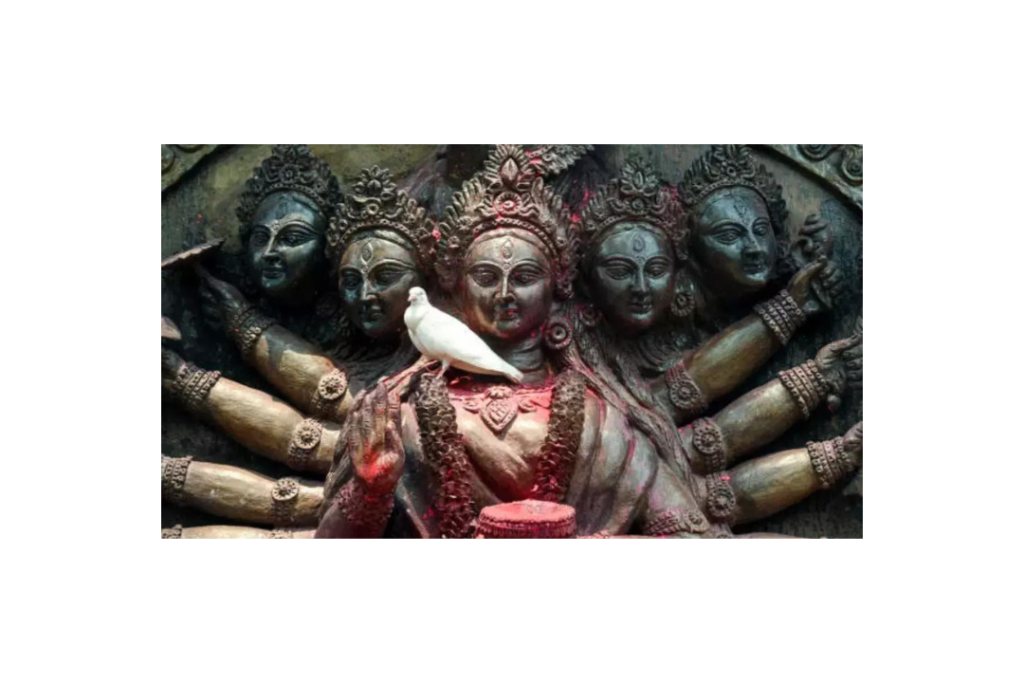The Profound Significance of Ambubachi Mela at Kamakhya Temple: A Historical and Cultural Odyssey
Every year, thousands of devotees flock to the Kamakhya Temple in Guwahati, Assam, for the Ambubachi Mela, an enormous celebration held there. During this significant celebration, which corresponds with Goddess Kamakhya’s monthly menstrual cycle, the temple’s holy doors are closed for four days. At 9:07 PM on June 25, worship resumes, signaling the end of this holy time.
Table of Contents

The Historical Tapestry of Kamakhya Temple
The Kamakhya Temple, one of the most respected sanctuaries dedicated to Goddess Kamakhya, also known as Goddess Sati, is perched atop the Nilachal Hills. A significant pilgrimage site, particularly during the Ambubachi Mela, is this temple. The origin of the temple is steeped in antiquated legends and myths, most notably that of King Narakasura, the demon king of Pragjyotishpur.
The Myth of King Narakasura and Goddess Kamakhya
According to legend, King Narakasura was a great admirer of Goddess Kamakhya and longed to marry her. But, the goddess, who would never wed a demon, issued an almost impossible challenge to Narakasura: he had to build a stone road from the southern reaches of the Nilachal Hills to the temple in a single night.
The Fabrication of Mekhela Ujua Path
King Narakasura took the challenge, unfazed, and almost finished the task before daybreak. Goddess Kamakhya was startled by his approach and summoned a magical rooster to crow to announce the arrival of day. Narakasura thought he had stumbled, having been duped by the early crowing. Feeling furious, he killed the rooster, and the spot where it died is now known as Kukurakata. One of the primary parts of the pilgrimage route is still in place: the stone staircase he forged, called the Mekhela Ujua Path.
Also, Read : Uncovering the Vaishakh Month’s Spiritual Importance: Customs, Theories, and Astrological Curatives
The Cultural Gravitas of Ambubachi Mela
Ambubachi Mela is a celebration of fecundity, womanhood, and the powerful divine feminine that goes beyond simple religious attendance. It is thought that the ground becomes fruitful during these four days, reflecting Goddess Kamakhya’s menstrual cycle.
Rites and Customs
The temple doors stay closed during the Ambubachi Mela, and all everyday worship is halted. The temple is only reopened following the completion of purification rites, according to devotees, who believe that the goddess goes through her yearly menstrual cycle during this time.
The Resplendent Reopening Ceremony
There is a big reopening of the temple. Following her ritual washing, thousands of devotees assemble to witness the goddess’s first darshan. Chants and hymns flood the temple grounds, bringing a sense of dedication to the area.
Also, Read : Celebrating Vat Purnima with Devotion: Embracing Love and Legacy
Pilgrimage to Kamakhya Temple
It is necessary to follow the Mekhela Ujua Path in order to go to Kamakhya Temple. This old staircase, which is said to have been crafted by Narakasura, gives the trip a touch of the past. Often going barefoot, pilgrims embark on this journey with great dedication as a sign of respect and penance.
The Spiritual Sojourn
Traveling to Kamakhya Temple is said to have a spiritually transforming effect. Hikers think that climbing the old stairs cleanses them of their sins and brings them closer to God. Encouraging views of the Nilachal Hills on each side of the path add to the spiritual journey.

The Architectural Splendor of Kamakhya Temple
In addition to its spiritual significance, Kamakhya Temple is well-known for its distinctive and exquisite architectural design. With its remarkable tower and intricate carvings, the temple is a prime example of medieval Assamese architecture.
Architectural Hallmarks
Several minor shrines to different gods are included in the temple complex. A yoni-shaped stone, representing the goddess, is kept in the main sanctum sanctorum. The temple’s architecture, which blends local customs with historical influences, is a sight to behold.
Conservation Endeavors
It is crucial to preserve the Kamakhya Temple and its customs. To preserve the surrounding ecology and the structural integrity of the temple, a number of activities are implemented.
The Mythological Essence of Goddess Kamakhya
Considered the personification of fertility and feminine vitality, the goddess Kamakhya is highly venerated. Her devotion is intertwined with several legends and customs that celebrate her benevolence and strength.
Also, Read : Transformative Wisdom: Embracing the Guru Shishya Legacy for Modern Success
The Saga of Sati
One well-known myth involving Goddess Kamakhya is the story of Sati. According to legend, Sati, the consort of Lord Shiva, set herself on fire to express her displeasure over her father’s disparaging remarks. Shiva, distraught, carried her body across the universe, and pieces of her dropped at different locations, becoming Shakti Peethas (holy sites). Her yoni, or womb, is said to have descended from the Kamakhya Temple, signifying creation and fertility.
The Ambubachi Mela’s Role in Tourism Promotion
In Assam, the Ambubachi Mela is a major tourism catalyst. Devotees from all over the country and the world come to Guwahati, which becomes a hive of activity.
Economic Repercussions
The festival’s large earnings have a beneficial effect on the regional economy. Local businesses like motels and restaurants see a spike in business during this period. Additionally, the mela provides a venue for regional artisans and traders to open up shop and sell their goods.
Also, Read : Embrace the Ganga Dussehra 2024 Sacred Spirit
Cultural Confluence
Ambubachi Mela acts as a crossroads of civilizations, bringing people of all origins together in a spirit of dedication. Different communities’ social links are strengthened and mutual understanding is fostered by this mixing of cultures.
Environmental Stewardship
Managing the environmental impact is crucial during the Ambubachi Mela due to the significant number of guests. Strategies are in place to control waste and preserve the natural beauty of the Nilachal Hills, and measures are put in place to guarantee that the event is celebrated sustainably.
Sustainable Initiatives
To reduce the festival’s environmental impact, measures like plastic bans, eco-friendly waste management, and awareness programs are implemented. In order to keep the sacred location clean and safe, organizers work with devotees.
Also, Read : The Profound Essence of Nirjala Ekadashi Fasting in Hinduism

Conclusion
At Kamakhya Temple during the Ambubachi Mela, myth, spirituality, and culture are blended together in a harmonious way.It honors the divine feminine while celebrating creation and reproduction. Not only is the festival a religious event, but it also signifies a significant moment in Assamese culture and the nation’s economy. The mythology and traditions of the Kamakhya Temple, an enduring emblem of faith and devotion, draw millions of worshipers.
An unforgettable experience, a visit to the Kamakhya Temple during the Ambubachi Mela provides deep insights into Assamese mythology and legends’ enduring heritage.
For the latest news from across India, Political updates, Technology, Science, Automobile, Sports News, Lifestyle, Entertainment, Mythological Updates and more Top News, visit and Subscribe to our Now Mirror.
Also, Read : The Sacred Shaligram Stone: Significance, Rituals, and Benefits





